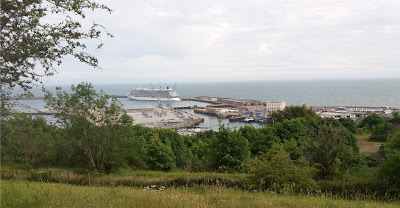On Friday Mrs PBT’s and I are embarking on our first ever
cruise. It’s billed as a “taster cruise” and, as the name suggests, is designed
to give novice, “cruise virgins” like us, the chance to experience life afloat,
combined with that touch of luxury that seems to be an essential part of the
whole package.
We’ll be accompanied on the voyage, by’s Eileen’s sister and
her husband, who are both cruise veterans. They have offered to act as our
guides, although I suspect their real reason is the desire to enjoy a short
break, as what can be a depressing time of year.
Without wishing to appear smug, or ungrateful, neither of us
really need “guiding,” as surely part of the fun is finding things out for
oneself, but having said that, my sister
and brother-in-law obviously know the ropes, and it will be with the little
things where their experience will undoubtedly come to the fore.This being our first cruise, we are pushing the boat out, if you’ll excuse the pun, and will be sailing from Southampton on the Queen Elizabeth; Cunard’s newest ocean liner. If we enjoy it, there’s the possibility of a longer cruise next year, with the Norwegian fjords being my voyage of choice.
Mrs PBT’s still doesn’t feel up to being herded around at airports, even though assisted boarding is available at most locations, so the idea of a cruise, where we can just drive down to Southampton, hand over the car keys, and leave the vehicle to be parked, whilst our cases are delivered direct to our cabin, obviously appeals. I did tell her that isn’t an excuse to pack everything but the proverbial kitchen sink!
I’ve had to pack rather more than I would normally take, and certainly quite a bit more than I took on my recent visit to Krakow, where I crammed everything into a medium-sized rucksack in order to fly with just cabin baggage. That certainly beats queuing at check-in and waiting at baggage reclaim.
Back to the point, dinner on board the Queen Elizabeth is a
formal affair – not quite DJ’s and dickey-bows, but smart attire nevertheless,
including a jacket which would not travel well crumpled inside a rucksack.
Our destination is the Belgian port
of Zeebrugge; a town once again in
the news for all the wrong reasons. Our ship will dock there for a day, and
there are several shore excursions to take advantage of. These are not cheap,
and are undoubtedly an easy way for cruise lines to bump up their profits.
Destinations for these excursions include trips to Bruges,
Ghent or the First World War
Commonwealth cemeteries. All involve a fair amount of walking, which neither of
the ladies feel up to, so we’ve agreed to forsake the coach trips, and spend
time ashore at Zeebrugge.
I’ve been to Bruges
several times, so am not overly concerned at not seeing the place again, but I
would have liked to visit Ghent.
Also, a trip to the war graves would have been particularly poignant this time
of year, but with several operators offering tailor-made guided tours, that is
something that can wait for another time.
So with packing well on the way to completion, and then a drive
down to Southampton for an overnight stay, tomorrow
morning, there’s just one last thing for me to say.
I was being economical with the truth at the beginning of
this post, as I am not a “cruise virgin.” Instead I am the person who, at the
tender age of 16, undertook a two week “educational cruise” as a member of a
party from my school, along with similar groups of pupils from schools all over
Kent.
The “SS Nevassa,” a converted troop ship operated by the now defunct British India Line, acted as our home
for a fortnight, as we cruised around the mid-Atlantic, visiting Portugal,
the Canaries, Madeira and the Azores.
Being “educational” there were lectures, films and slideshows about the places
we would be calling at, and there was also plenty to keep a boatful of lively
teenagers amused, (no alcohol though, for obvious reasons).
I thoroughly enjoyed the experience, especially as it was my
first time abroad, and have fond memories of life on-board ship. I even found a
few old photo’s, taken on my Kodak Brownie camera. (For those who might be interested, I'm the one in the back row with the scruffy haircut, third from the left).
This time though, I’ll be swapping a rather spartan dormitory
for a balcony stateroom, and an equally basic ship’s mess-room for fine dining.
I will, of course, keep people posted, but not whilst at sea.












































